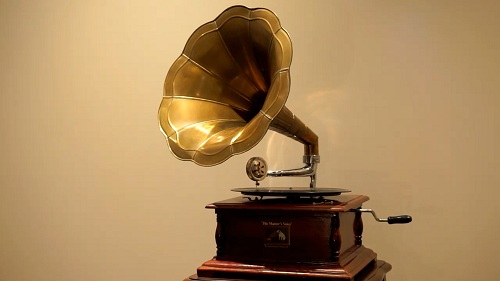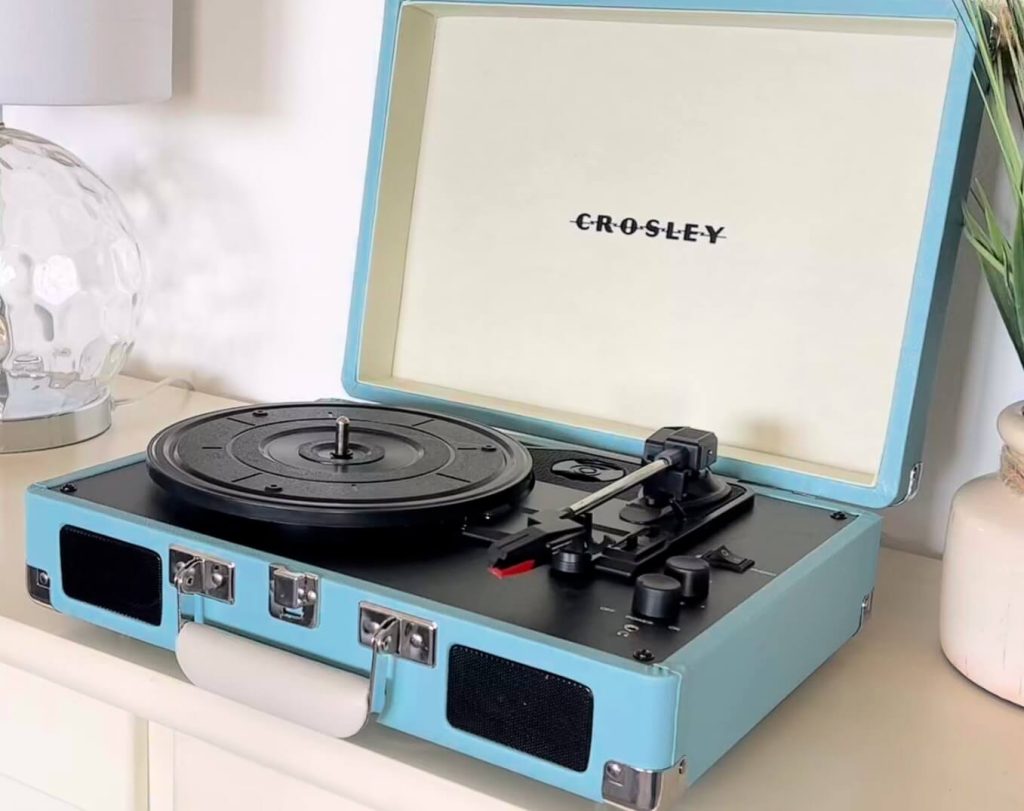Disclosure: This article contains affiliate links and as an Amazon Associate, we earn from qualifying purchases made through our links.
Well, the gramophone is the evolved version of a phonograph, and record players are a further evolved version of the gramophone.
Although all these devices share a common goal i.e. track the record or cylinder grooves and convert the vibrations to the sound but the working concepts of all these devices are different from each other.
But unlike the phonograph, there is one common thing between the gramophone and the record player i.e. both use discs as a sound playback medium. The discs (known as records in the modern day) as a sound playback medium defeated the wax cylinders and since then, it has become one of the most popular sound recording mediums which indirectly increased the demand for gramophones in the 20th century.
And, that’s one of the main reasons why most people’s grandpas had this device at home. Even, my grandpa owned one of these legacy devices and he introduced the music to me through this device.
Well, growing up listening to music on the gramophone and seeing, high-end record players with modern technology launches in recent years mostly makes anyone curious to know how does record works and the difference between a gramophone and a record player.
You must also be curious, and that’s why you have landed on this article.
So, to help you understand the difference, we have drafted this article in which we have compared both devices according to their design, features, components, characteristics, etc., and shared all the in-depth insights.
Previously, we have compared gramophone vs phonograph, phonograph vs record player, record player vs turntable, and today, we are discussing the difference between a gramophone and a record player.
Interesting read: How does a phonograph work?

AT-LP60X-BK with Edifier R1280DB speakers
A beginner-friendly combo to kickstart your vinyl journey — no extra phono preamp or amplifier needed!
- Beginner-friendly
- Complete plug-and-play setup
- Fully automatic turntable
- High-fidelity sound
- Sleek design and easy to use
Gramophone Vs Record Player:
| Gramophone | Record Player | |
|---|---|---|
| Definition | The evolved version of the phonograph which can play discs with mechanical energy is known as the gramophone. | A unit that consists of a turntable, phono preamp, amplifier, and speakers in a single unit is known as a record player. |
| Sound Recording & Playback Medium | Shellac records | Vinyl records & shellac records |
| Speed (RPM) | Early discs have 60 to 130RPM speed but in the end, 78RPM is standardized | Supports multiple speed: 33(1/3) RPM, 45RPM and 78RPM |
| Playback Time | The early discs play for 2 minutes to 3(1/2) minutes. | 5(1/3) minutes to 22 minutes per side |
| Works on | Mechanical Energy | Electricity |
| Sound Quality | Good quality | On a whole new level as compared to the gramophone. |
| Cartridge | No cartridge | Ceramic cartridge |
| Stylus Material | Thorn, fiber, or steel | Diamond |
| Phono Preamp/Amplifier | No | Yes |
| Speakers | No | Yes |
| Durability | More durable | Less durable |
| Cost | Costly | Cheaper |
So, this is the brief difference between a gramophone and a record player.
Now, let’s talk about these devices separately and after that, we will share the in-depth difference between these units.
What is a Gramophone:

A gramophone is an improved version of the phonograph in which discs are used as a medium for sound storage and playback instead of wax cylinders.
In the 1880s, Alexander Graham Bell’s Volta Laboratory made several improvements to phonographs, like using wax-coated cardboard cylinders and cutting styli. But in the 1890s, Emile Berliner made a major advancement and introduced the flat discs on which the grooves are engraved from the side to the center, just like normal vinyl records in the current era.
The early discs were single-sided 7-inch with a speed of 70 RPM and a playback time of around 2 minutes, which is the same as wax cylinders, but at that moment, the phonograph had the upper hand because wax cylinders are reusable while discs are pre-recorded and can’t be reused.
In 1903, Victor introduced the 12-inch record that increased the playing time to three and a half minutes with 78 RPM speed.
However, Edison tried completing the disc by launching wax cylinders with 4-minute playback along with 4-minute compatible phonographs.
But, the disc had several advantages, i.e., the recording could be done on both sides, the master disk creation was easier as compared to the master cylinder, stamping the shellac material with the master stamper is a lot easier, and bulk manufacturing can be done smoothly, which was the major concern back then because, with the increasing demand, the artist needed to record their music multiple times to fulfill the demand.
These small advantages and advancements received positive feedback from users, which helped the gramophone disc win the commercial battle against wax cylinders in the 1910s.
After that, these discs became the most dominant commercial audio distribution format for the entire 20th century, and the decline of phonographs started.
With the advancement in technology, the companies kept improving the design, drive system, pickup system, stylus, sound equalization, and much more. With these continuous improvements, we have the record players and turntables on which we play our vinyl records today.
What is a Record Player:

A record player is a single unit that consists of a turntable, phono preamp, amplifiers, and speakers. These units are further improved versions of the gramophone that have a different working concept.
Instead of using a horn as a sound output medium, record players use speakers. In this unit, the stylus runs on the grooves and fetches audio signals that get converted into electric signals by a turntable phono cartridge. These electric signals are further amplified by phono preamp and amplifier to become audible on speakers.
Currently, the most popular record players are Crosley and Victrola.
Difference Between Gramophone And Record Player:
Now, we are covering every aspect mentioned in the comparison table in depth.
Sound Quality:
The sound quality of a gramophone shouldn’t be compared with a modern device. As you know, the technology has evolved a lot and nowadays, a good quality turntable or record player can easily beat gramophone in sound quality.
You can listen to the sound quality difference in the following video:
Records:
The gramophone can play shellac records only while the modern-day record players can play vinyl records as well as shellac records.
Power Source:
Like a Phonograph, a gramophone also works on mechanical energy, i.e., you need to wind it up using the hand crank until it is fully wounded and the disc will start spinning.
On the other hand, the record player works on electricity. You need to plug the adapter into the power outlet to play your vinyl records.
Playback Time:
Gramophone Playback Time:
The playback time of the discs manufactured at the beginning of the 20th century was 2 minutes but the playback time was extended to 3½ minutes with a 12-inch disc introduced by Victor in 1903. Since then the manufacturers kept making advancements in the disc’s size and soon after, a 10inch 78 rpm record whose, playback time was around 3 minutes on both sides.
Record Player Playback Time:
The record player offers different playback times depending on the speed and size of the vinyl record. You will understand this better with the information mentioned in the table following:
| Record Size | RPM (Revolutions Per Minute) | Playback Time |
|---|---|---|
| 16 inch | 33(1/3) RPM | 15 min/side |
| 12 inch | 33(1/3) RPM | 22 min/side |
| 45 RPM | 15 min/side | |
| 78 RPM | 4–5 min/side | |
| 10 inch | 33(1/3) RPM | 12–15 min/side |
| 45 RPM | 9–12 min/side | |
| 78 RPM | 3 min/side | |
| 7 inch | 33(1/3) RPM | 7 min/side |
| 45 RPM | 5(1/3) min/side |
Durable:
The gramophone is more durable than a record player. As you already know, the gramophone was built with good quality material and thus, a gramophone manufactured at the beginning of the 20th century is still playable today. On the other hand, the record players are built with cheap quality materials and components.
Cost:
The gramophones are costlier to buy and maintain as compared to record players. A working gramophone in good condition will cost $$$ along with shellac records but on the other hand, a record player is available in the market for under $80.
Frequently Asked Questions:
Q1- Is a record player a gramophone?
A record player is the evolved version of a gramophone and both are a lot different from each other.
Q2- Is a gramophone a word for a record player?
No, the gramophone is a completely different musical equipment than a record player. Although, the record player has evolved from a gramophone and some old people do call record players a gramophone, in reality, both are different.
Q3- Can you play gramophone records on a record player?
Gramophone records are shellac records, also known as 78s. There are many record players and turntables in the market that offer 78 RPM speed. Using 78 RPM speed along with a shellac-supported phono cartridge and conical stylus, you can play gramophone records on your record players or turntables.
Source:
We have shared the in-depth difference between gramophone and record player in the simplest manner possible. If you still have questions about these devices then please comment below. We will get back to you as soon as possible.



Great insights! I always thought a gramophone and a record player were the same, but your explanation about their mechanisms and historical context really clarified the differences for me. Love the detail diving into how each plays a role in the music experience!
Really enjoyed this post! It’s fascinating to see the distinctions between gramophones and record players. I had no idea about the historical context and technological differences. Can’t wait to explore more about vintage audio equipment!
Great comparison! I’ve always been curious about the differences between gramophones and record players. Your explanation really helped clarify how their mechanics and sound quality differ. I appreciate the historical context too; it makes the evolution of music playback methods even more fascinating!
This was a really informative post! I never realized how distinct the mechanisms of gramophones and record players are. It’s fascinating to learn about their history and differences. I’m definitely more inclined to explore vintage gramophones now! Thanks for sharing!